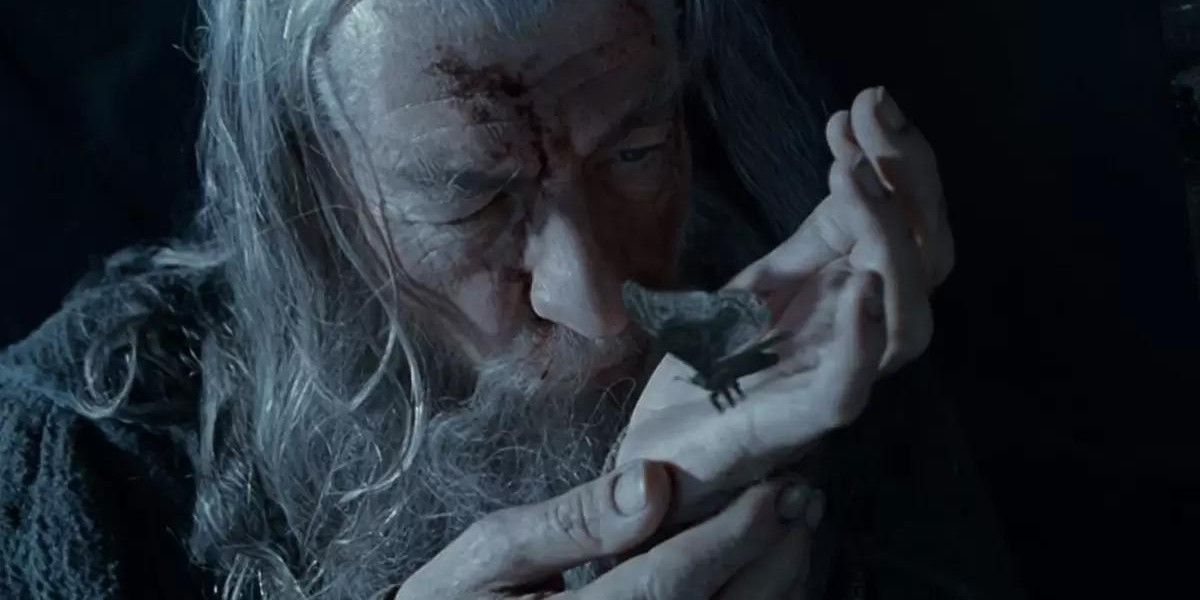
Similar events occurred towards the end of The Hobbit: An Unexpected Journey. When Azog’s Orcs chased Thorin’s Company into the trees, Gandalf noticed a moth in the branches. After coaxing it onto his staff, he sent it as a messenger to the Great Eagles, who came to fight the Orcs and fly Thorin’s Company to safety. These were some of the most memorable moments from Jackson’s Middle-earth films, thanks in no small part to Howard Shore’s stirring musical themes. Though the arrival of the Eagles on these three occasions came from J. R. R. Tolkien’s The Lord of the Rings and The Hobbit novels, the use of moths to bring messages to them was unique to the films.
Moths Inhabited Many of Middle-earth’s Forests
The moths that appeared in the films were Opodiphthera eucalypti or emperor gum moths.
Moths appeared a few times in Tolkien’s legendarium, but they were unrelated to Gandalf or the Great Eagles. In the chapter “A Short Rest” from The Hobbit, Thorin’s Company saw some “moths fluttering about” just outside Rivendell. Later, in the chapter “Flies and Spiders,” they encountered “thousands of dark-grey and black moths” in Mirkwood. They were especially large, and they swarmed the Dwarves whenever they lit a fire. These moths might have been a sign of Mirkwood’s corruption, similar to the giant spiders, but unlike the spiders, there was no indication that the moths were evil. They existed mainly to contribute to the spooky atmosphere of the cursed forest.
The novel version of The Lord of the Rings did not feature any moths, but it did reference them. In the chapter “The Riders of Rohan” from The Two Towers, Gimli proclaims, “I care no longer for the danger. Let the Orcs come as thick as summer moths around a candle!” In an early draft of the writings that would become The Silmarillion, Tolkien wrote that moths flew around Arwen’s ancestor, Tinúviel, when she danced in the woods. Tolkien pointed out that Elves liked moths while Men usually did not. However, in the final version of The Silmarillion, Tinúviel — or Lúthien as she was more commonly called — had no association with moths.
The Lord of the Rings’ Moths Served a Divine Purpose

In real life, many members of the Elachista genus of moths are named after Elves from The Silmarillion.
Within the film’s continuity, fans can only guess at the nature of the moths. They might have been ordinary insects, as the Istari were shown to be capable of communicating with animals; Saruman used birds as his spies, and Radagast conversed with many woodland creatures. Yet the fact that moths always appeared when Gandalf needed them most indicated that there was something special about them. In Tolkien’s lore, the Great Eagles were servants of Manwë, the King of the Valar, so the moths may have been as well. Manwë’s domain was the sky, so it would make sense for flying creatures like moths to serve him.
Moths were also a recurring motif in Prime Video’s The Lord of the Rings: The Rings of Power. When the Stranger defeated the Mystics at the end of the first season, they dissolved into moths, and in the second season, the Dark Wizard performed a ritual to resurrect one of the Mystics from a cloud of moths. Like Gandalf, the Dark Wizard was one of the Istari, and the Mystics’ power came from him. Perhaps, in The Rings of Power‘s version of Middle-earth, moths are inherently magical creatures with a connection to the Order of Wizards. Tolkien had a deep appreciation for nature, including creatures that are often feared or overlooked, so even though the messenger moths did not come from his writing, they played into the themes of his work.


